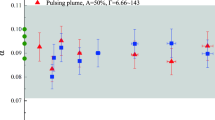Abstract
The water flow is studied when a thin body, part-submerged in originally still water, is plunged vertically downward. The rapid motion is at medium-to-large Reynolds number. The flow structure consists mainly of two viscous nonlinear layers, namely the unsteady boundary layer on the plunging body and unsteady wake along the trailing free surface, and one inviscid linear region in the bulk of the water. The former produce unsteady displacements which force the motion in the inviscid bulk, along with mixed boundary conditions, and control the evolutions of the wake-side and upper free surfaces. Other regions present are also considered. Analytical and numerical solutions are described, including the effects of the high Froude number and of contact slippage, and the time to bubble formation on the body.
Similar content being viewed by others
References
P.R. Garabedian, Oblique water entry of a wedge. Comm. Pure Appl. Math. 6 (1953) 157–165.
J.F. Thompson, Numerical solution of flow problems using body-fitted coordinate systems. In: W. Kollman (ed.), Computational Fluid Dynamics. Washington (D.C.): Hemisphere Pub. Corp. (1980) 1–98.
M. Greenhow, Wedge entry into initially calm water. Appl. Ocean Res. 9 (1987) 214–223.
D.G. Dommermuth, D.K.P. Yue, W.M. Lin, R.J. Rapp, E.S. Chan and W.K. Melville, Deep-water plunging breakers: a comparison between potential theory and experiments. J. Fluid Mech. 189 (1988) 423–442.
S.D. Howison, J.R. Ockendon and S.K. Wilson, Incompressible water-entry problems at small deadrise angles. J. Fluid Mech. 222 (1991) 215–230.
M.J. Cooker, Recent numerical calculations of two-dimensional jets induced by breaking-wave impact; a comment. Phil. Trans. R. Soc. A355 (1997) 687–689.
M.J. Cooker, Violently erupting free-surface jets. In: A.C. King and Y.D. Shikmurzaev (eds.), Free-Surface Flows. Proc. IUTAM Symp., Birmingham, U.K. (2001) pp. 63–70.
M.J. Cooker, P.D. Weidman and D.S. Bale, Reflection of a high-amplitude solitary wave at a vertical wall. J. Fluid Mech. 342 (1997) 141–158.
S. Somalinga and A. Bose, Numerical investigation of boundary conditions formoving contact line problems. Phys. Fluids 12 (2000) 499–510.
R.G. Cox, The dynamics of the spreading of liquids on a solid surface. Part 1. Viscous Flow. J. Fluid Mech. 168 (1986) 169–194.
R.G. Cox, The dynamics of the spreading of liquids on a solid surface. Part 2. Surfactants. J. Fluid Mech. 168 (1986) 195–200.
R.G. Cox, Inertial and viscous effects in dynamic contact angles. J. Fluid Mech. 357 (1998) 249–278.
K. Stoev, E. Ramé and S. Garoff, Effects of inertia on the hydrodynamics near moving contact lines. Phys. Fluids 11 (1999) 3209–3216.
C. Härtel, E. Meiburg and F. Necker, Analysis and direct numerical simulation of the flow at a gravity-current head. Part 1. Flow topology and front speed for slip and no-slip boundaries. J. Fluid Mech. 418 (2000) 189–212.
M.G. Hall, The boundary layer over an impulsively started flat plate. Proc. R. Soc. London A310 (1969) 401–414.
D.P. Papadopoloulos, On the unsteady boundary layer and wake of a flat plate, and modelling water flow near a ship-side. Ph.D. thesis, Univ. of London (2000) 248. pp.
L. Li, D.P. Papadopoulos, F.T. Smith and G.-X. Wu,Water flow due to rapid part-submerged body movement. Proc. IUTAM Symp. on Free-Surface Flows, Birmingham, UK, July 2000. Kluwer pubs. (2001) 177–185.
C.A.J. Fletcher, Computational Techniques for Fluid Dynamics, vol. II (1991).
F.T. Smith and S.N. Timoshin, Planar flows past thin multi-blade configurations. J. Fluid Mech. 324 (1996) 355–377.
M. Sussman, P. Smereka and S. Osher, A level set approach for computing solutions to incompressible two-phase flow. J. Comp. Phys. 114 (1994) 146–159.
F.T. Smith, L. Li and G.-X. Wu, Air cushioning with a lubrication/inviscid balance. Submitted to J. Fluid Mech. (2001).
A.E.P. Veldman and A.I. van de Vooren, Drag of a finite flat plate. In: R.D. Richtmeyer (ed.): Lecture Notes in Physics 35. Berlin: Springer-Verlag (1976) 422–430.
A.P. Rothmayer and F.T. Smith, Incompressible Triple Deck Theory. CRC Handbook of Fluid Dynamics (1998) 823 pp.
K. Stewartson, On the flow near the trailing edge of a flat plate II. Mathematika 16 (1969) 106–121.
F.T. Smith, R.G.A. Bowles and L. Li, Nonlinear effects in absolute and convective instabilities of a nearwake. Eur. J. Mech. B19 (2000) 173–211.
Author information
Authors and Affiliations
Rights and permissions
About this article
Cite this article
Li, L., Papadopolous, D., Smith, F. et al. Rapid plunging of a body partly submerged in water. Journal of Engineering Mathematics 42, 303–319 (2002). https://doi.org/10.1023/A:1016179011822
Issue Date:
DOI: https://doi.org/10.1023/A:1016179011822




